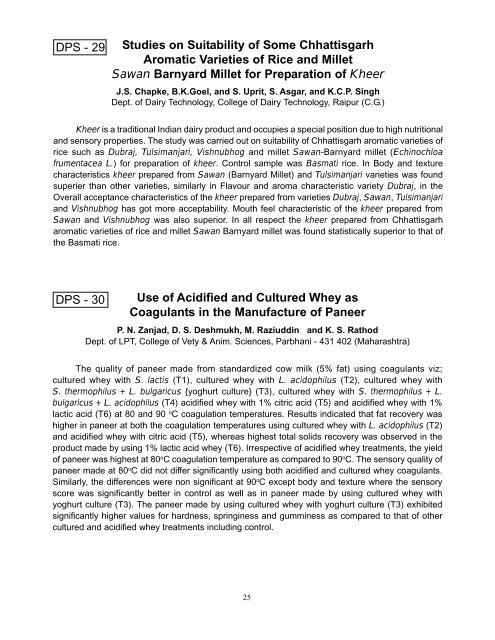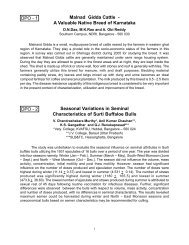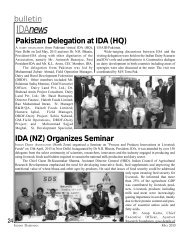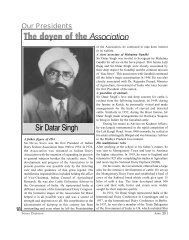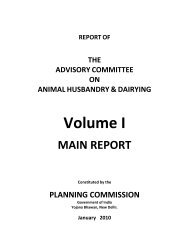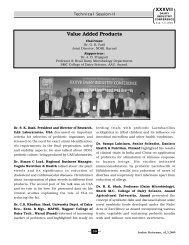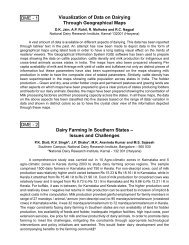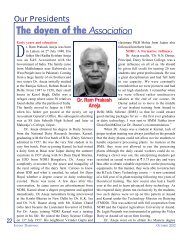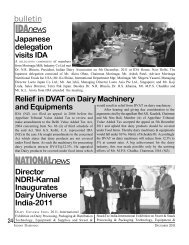Prevalence of Antibiotic Resistance in Dairy Strains of Streptococcus ...
Prevalence of Antibiotic Resistance in Dairy Strains of Streptococcus ...
Prevalence of Antibiotic Resistance in Dairy Strains of Streptococcus ...
Create successful ePaper yourself
Turn your PDF publications into a flip-book with our unique Google optimized e-Paper software.
DPS - 29Studies on Suitability <strong>of</strong> Some ChhattisgarhAromatic Varieties <strong>of</strong> Rice and MilletSawan Barnyard Millet for Preparation <strong>of</strong> KheerJ.S. Chapke, B.K.Goel, and S. Uprit, S. Asgar, and K.C.P. S<strong>in</strong>ghDept. <strong>of</strong> <strong>Dairy</strong> Technology, College <strong>of</strong> <strong>Dairy</strong> Technology, Raipur (C.G.)Kheer is a traditional Indian dairy product and occupies a special position due to high nutritionaland sensory properties. The study was carried out on suitability <strong>of</strong> Chhattisgarh aromatic varieties <strong>of</strong>rice such as Dubraj, Tulsimanjari, Vishnubhog and millet Sawan-Barnyard millet (Ech<strong>in</strong>ochloafrumentacea L.) for preparation <strong>of</strong> kheer. Control sample was Basmati rice. In Body and texturecharacteristics kheer prepared from Sawan (Barnyard Millet) and Tulsimanjari varieties was foundsuperier than other varieties, similarly <strong>in</strong> Flavour and aroma characteristic variety Dubraj, <strong>in</strong> theOverall acceptance characteristics <strong>of</strong> the kheer prepared from varieties Dubraj, Sawan, Tulsimanjariand Vishnubhog has got more acceptability. Mouth feel characteristic <strong>of</strong> the kheer prepared fromSawan and Vishnubhog was also superior. In all respect the kheer prepared from Chhattisgarharomatic varieties <strong>of</strong> rice and millet Sawan Barnyard millet was found statistically superior to that <strong>of</strong>the Basmati rice.DPS - 30Use <strong>of</strong> Acidified and Cultured Whey asCoagulants <strong>in</strong> the Manufacture <strong>of</strong> PaneerP. N. Zanjad, D. S. Deshmukh, M. Raziudd<strong>in</strong> and K. S. RathodDept. <strong>of</strong> LPT, College <strong>of</strong> Vety & Anim. Sciences, Parbhani - 431 402 (Maharashtra)The quality <strong>of</strong> paneer made from standardized cow milk (5% fat) us<strong>in</strong>g coagulants viz;cultured whey with S. lactis (T1), cultured whey with L. acidophilus (T2), cultured whey withS. thermophilus + L. bulgaricus {yoghurt culture} (T3), cultured whey with S. thermophilus + L.bulgaricus + L. acidophilus (T4) acidified whey with 1% citric acid (T5) and acidified whey with 1%lactic acid (T6) at 80 and 90 o C coagulation temperatures. Results <strong>in</strong>dicated that fat recovery washigher <strong>in</strong> paneer at both the coagulation temperatures us<strong>in</strong>g cultured whey with L. acidophilus (T2)and acidified whey with citric acid (T5), whereas highest total solids recovery was observed <strong>in</strong> theproduct made by us<strong>in</strong>g 1% lactic acid whey (T6). Irrespective <strong>of</strong> acidified whey treatments, the yield<strong>of</strong> paneer was highest at 80 o C coagulation temperature as compared to 90 o C. The sensory quality <strong>of</strong>paneer made at 80 o C did not differ significantly us<strong>in</strong>g both acidified and cultured whey coagulants.Similarly, the differences were non significant at 90 o C except body and texture where the sensoryscore was significantly better <strong>in</strong> control as well as <strong>in</strong> paneer made by us<strong>in</strong>g cultured whey withyoghurt culture (T3). The paneer made by us<strong>in</strong>g cultured whey with yoghurt culture (T3) exhibitedsignificantly higher values for hardness, spr<strong>in</strong>g<strong>in</strong>ess and gumm<strong>in</strong>ess as compared to that <strong>of</strong> othercultured and acidified whey treatments <strong>in</strong>clud<strong>in</strong>g control.25


